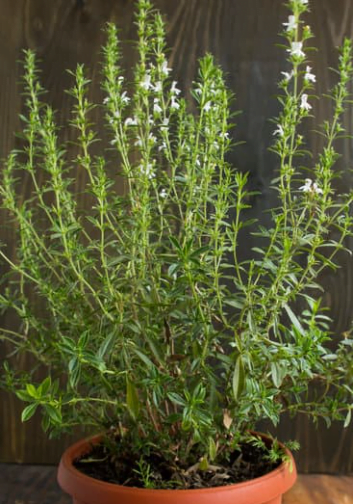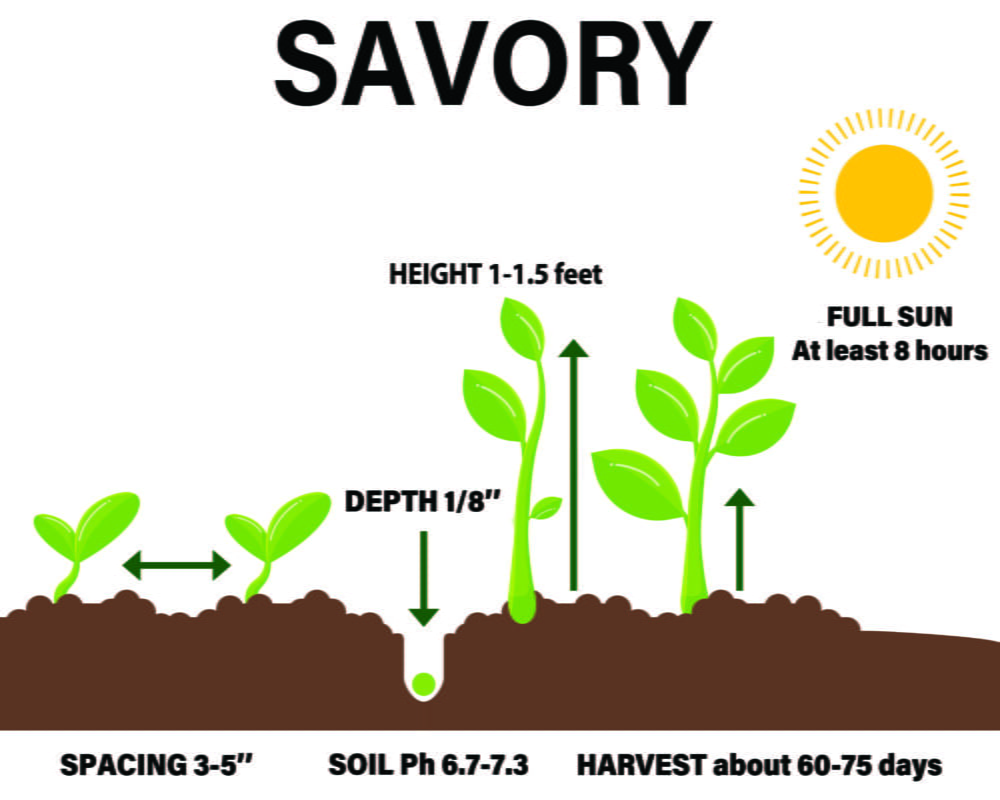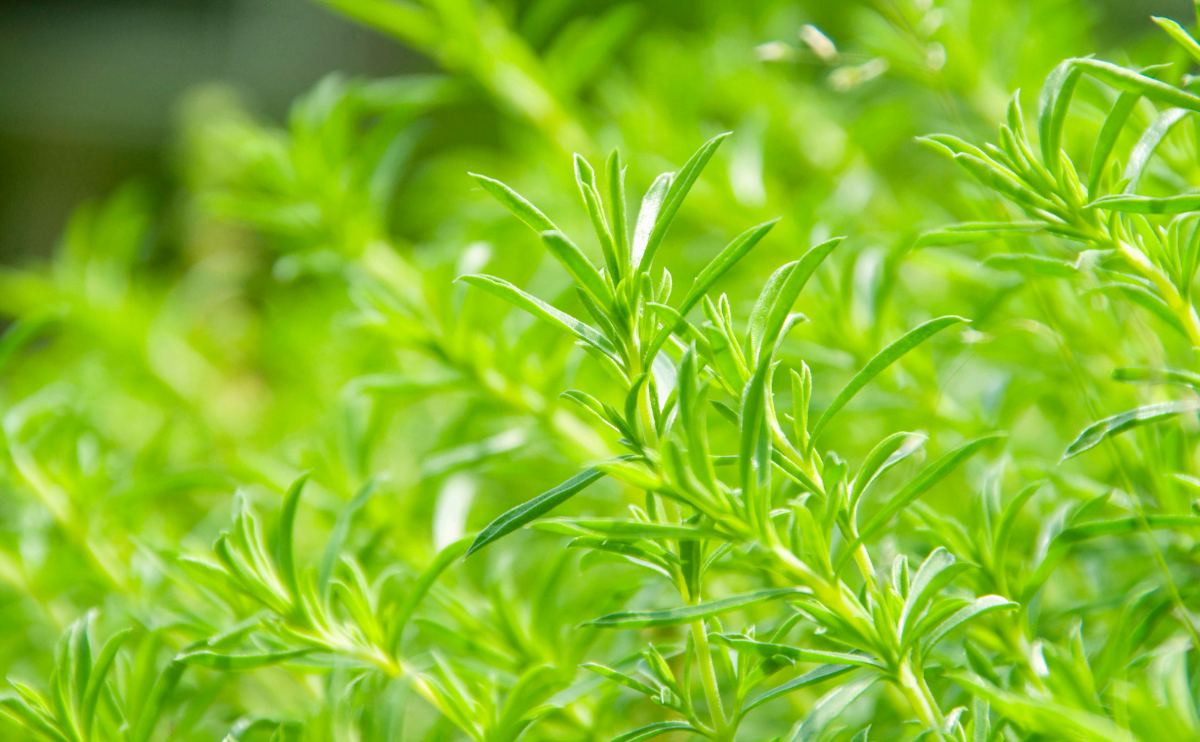Summer savory is an annual herb that is part of the mint family. It’s sometimes used as a substitute, or in conjunction with rosemary, thyme, or sage. With a peppery flavoring, it’s less bitter than its winter savory relative.
The herb is a low-growing shrub with narrow green leaves. During the summer, flowers appear on the plant which can be white, lilac, or pink. Because summer savory is a fast-growing annual plant, it only grows through the summer months. Plant summer savory seeds in the spring.

| Botanical Name | Satureja hortensis |
| Common Name | Summer savory |
| Plant Type | Annual herb |
| Mature Size | 12-24 in. tall |
| Sun Exposure | Full sun |
| Soil Type | Loamy |
| Soil pH | 6.6-7.5 |
| Bloom Time | Summer |
| Flower Color | Pink, lilac, or white |
| Hardiness Zones | 1-11 (USDA) |
| Native Area | Eastern Mediterranean, the Caucasus |

When to Plant?
This will be determined by your planting zone. There is a final frost date for each area. As a result, you can plan your gardening activities around this date. Check our Frost Dates Across North America: First & Last Frost Dates Chart. However, the date will not be the same for every plant.
How to Plant
Sow seed indoors as early as 6 to 8 weeks before the last frost. Seeds can take 14 days or longer to germinate. Summer savory prefers a rich, well-drained organic soil.
Choose from either clay or plastic pots based on your personal preference.
If growing a single plant, a 6″ deep and wide pot is sufficient.
Three plants can be grown together in a 12″ deep and wide container.
Plant seeds 3 to 5 inches apart and about 1/8 of an inch down in the soil.

Bright, spicy, and slightly sweet, savory has been known for ages in European cuisines, notably in France and Bulgaria. Used for millennia as a seasoning, it also has powerful medicinal properties. Native to the eastern Mediterranean and the Caucasus, savory is a highly aromatic herb. It features a hot, peppery flavor with notes of thyme, mint, and marjoram. Companions: Grow summer savory with beans, onions, garlic, and tomatoes.
How To Cultivate
Soil – Summer savory grows best in well-drained, sandy soil, pH 6.3 – 7.5. Add compost to the soil before planting for nutrients. Mulch lightly to help the soil retain moisture.
Sun – Prefers full sun.
Spacing – 10 – 12 inches apart.
Water-Water regularly to keep the soil moist, not soggy. Be cautious with watering but ensure the soil is never dry. Regular watering is essential, especially in dry conditions.
Fertilizer – Generally not need
ed if planted in compost-rich soil.
If necessary, use a light application of balanced organic fertilizer mid-season.How To Harvest
Summer Savory can be harvested when it reaches about 6 – 8 inches tall. Harvest by cutting the tips of branches to encourage fuller growth. Harvest frequently, but do not remove more than one-third of the plant at once. Collect leaves before the plant flowers for the best flavor.
Snip off the top leaves and shoots; this will allow the plant to become bushier. Fresh leaves can be stored by placing them in water in the refrigerator or drying them for long-term use.
Hydroponics
Germination: Soak the Summer savory seeds in water for about 24 hours to help with the germination process. After soaking, transfer the seeds to a germination medium, such as a seedling tray or a rockwool cube. Keep the germination medium moist, but not overly wet. Place the tray or cube in a warm and dark location for 2-3 days until the seeds germinate and develop into seedlings. Once the seedlings have grown to a sufficient size, transfer them to the hydroponic system.
pH range: Summer savory grows best in a pH range between 6.0 and 7.0. Regular monitoring of the pH level of the nutrient solution is essential to ensure healthy growth.
EC: The ideal electrical conductivity (EC) level for Summer savory is between 1.2 and 2.2 mS/cm. This can be measured using a handheld EC meter and adjusted as needed.
PPM: The recommended parts per million (PPM) range for growing Summer savory is between 800 and 1600. This can be measured using a TDS/PPM meter and adjusted as needed.
Humidity: Summer savory prefers a humidity level between 40% and 60%. Humidity can be maintained by using a humidifier or dehumidifier, depending on the ambient humidity level in the growing area.
Light hours: Summer savory requires around 12-14 hours of light per day for optimal growth. Supplemental grow lights may be required if natural light is insufficient.
Temperature air: The ideal air temperature range for growing Summer savory is between 68°F and 78°F (20°C to 25°C). Temperatures above 85°F (29°C) can negatively affect the plant’s growth.
Temperature water: The water temperature range for growing Summer savory hydroponically is between 65°F and 75°F (18°C to 24°C). It is essential to monitor the water temperature regularly and adjust it as needed to maintain optimal growing conditions.
Overall, growing Summer savory hydroponically can be a simple and rewarding process. By following these guidelines and monitoring the plant’s nutrient levels and environmental conditions, you can produce healthy and flavorful Summer savory plants.
Common Pests and Diseases
This is a tough plant, with no notabe pest or disease problems. Rather, it is known to keep pests away with its strong scent.


